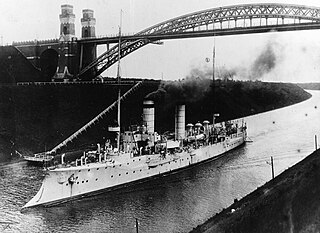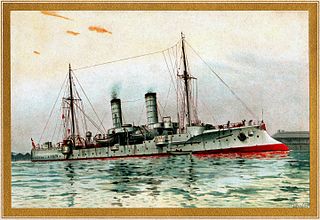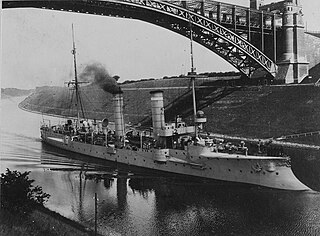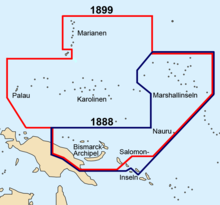
SMS Seeadler was an unprotected cruiser of the Bussard class, the third member of a class of six ships built by the German Kaiserliche Marine. Her sister ships included Bussard, the lead ship, along with Falke, Condor, Cormoran, and Geier. Seeadler was built at the Kaiserliche Werft in Danzig in late 1890, launched in February 1892, and commissioned in August of that year. Intended for colonial service, Seeadler was armed with a main battery of eight 10.5-centimeter (4.1 in) guns and had a top speed of 15.5 knots.

SMS Gneisenau was a Bismarck-class corvette built for the German Imperial Navy in the late 1870s. The ship was named after the Prussian Field Marshal August von Gneisenau. She was the fifth member of the class, which included five other vessels. The Bismarck-class corvettes were ordered as part of a major naval construction program in the early 1870s, and she was designed to serve as a fleet scout and on extended tours in Germany's colonial empire. Gneisenau was laid down in June 1877, launched in September 1879, and was commissioned into the fleet in October 1880. She was armed with a battery of fourteen 15 cm (5.9 in) guns and had a full ship rig to supplement her steam engine on long cruises abroad.

SMS Arcona was the ninth member of the ten-ship Gazelle class of light cruisers that were built for the German Kaiserliche Marine in the late 1890s and early 1900s. The Gazelle class was the culmination of earlier unprotected cruiser and aviso designs, combining the best aspects of both types in what became the progenitor of all future light cruisers of the Imperial fleet. Built to be able to serve with the main German fleet and as a colonial cruiser, she was armed with a battery of ten 10.5 cm (4.1 in) guns and a top speed of 21.5 knots. Arcona was a modified version of the basic Gazelle design, with improved armor and additional coal storage for a longer cruising range.

SMS Gazelle was the lead ship of the ten-vessel Gazelle class of light cruisers that were built for the German Kaiserliche Marine in the late 1890s. The Gazelle class was the culmination of earlier unprotected cruiser and aviso designs, combining the best aspects of both types in what became the progenitor of all future light cruisers of the Imperial fleet. Built to be able to serve with the main German fleet and as a colonial cruiser, she was armed with a battery of ten 10.5 cm (4.1 in) guns and a top speed of 19.5 knots. Her Niclausse boilers proved to be troublesome in service, and these were later replaced in the mid-1900s.

SMS Gefion was an unprotected cruiser of the German Kaiserliche Marine, the last ship of the type built in Germany. She was laid down in March 1892, launched in March 1893, and completed in June 1895 after lengthy trials and repairs. The cruiser was named after the earlier sail frigate Gefion, which had been named for the goddess Gefjon of Norse mythology. Intended for service in the German colonial empire and as a fleet scout, Gefion was armed with a main battery of ten 10.5-centimeter (4.1 in) guns, had a top speed in excess of 19.5 knots, and could steam for 3,500 nautical miles, the longest range of any German warship at the time. Nevertheless, the conflicting requirements necessary for a fleet scout and an overseas cruiser produced an unsuccessful design, and Gefion was rapidly replaced in both roles by the newer Gazelle class of light cruisers.

SMS Medusa was a member of the ten-ship Gazelle class of light cruisers that were built for the German Kaiserliche Marine in the late 1890s and early 1900s. The Gazelle class was the culmination of earlier unprotected cruiser and aviso designs, combining the best aspects of both types in what became the progenitor of all future light cruisers of the Imperial fleet. Built to be able to serve with the main German fleet and as a colonial cruiser, she was armed with a battery of ten 10.5 cm (4.1 in) guns and a top speed of 21.5 knots. Medusa served in all three German navies—the Kaiserliche Marine, the Reichsmarine of Weimar Germany, and the Kriegsmarine of Nazi Germany—over the span of over forty years.

SMS Thetis was the fourth member of the ten-ship Gazelle class of light cruisers that were built for the German Kaiserliche Marine in the late 1890s and early 1900s. The Gazelle class was the culmination of earlier unprotected cruiser and aviso designs, combining the best aspects of both types in what became the progenitor of all future light cruisers of the Imperial fleet. Built to be able to serve with the main German fleet and as a colonial cruiser, she was armed with a battery of ten 10.5 cm (4.1 in) guns and a top speed of 21.5 knots.

SMS Stosch was a Bismarck-class corvette built for the German Imperial Navy in the late 1870s. The ship was named for Admiral Albrecht von Stosch, the first chief of staff of the newly created Imperial Navy. She was the third member of the class, which included five other vessels. The Bismarck-class corvettes were ordered as part of a major naval construction program in the early 1870s, and she was designed to serve as a fleet scout and on extended tours in Germany's colonial empire. Stosch was laid down in November 1875, launched in October 1876, and was commissioned into the fleet in June 1879. She was armed with a battery of ten 15 cm (5.9 in) guns and had a full ship rig to supplement her steam engine on long cruises abroad.

SMS Bismarck was a Bismarck-class corvette built for the German Imperial Navy in the late 1870s. She was the lead ship of her class, which included five other vessels. The Bismarck-class corvettes were ordered as part of a major naval construction program in the early 1870s, and she was designed to serve as a fleet scout and on extended tours in Germany's colonial empire. Bismarck was laid down in November 1875, launched in July 1877, and was commissioned into the fleet in August 1878. She was armed with a battery of sixteen 15 cm (5.9 in) guns and had sails, a full ship rig to supplement her steam engine on long cruises abroad.

SMS Leipzig was a German flush-deck steam corvette, the lead ship of the Leipzig class, named after the 1813 Battle of Leipzig. She was built for the Kaiserliche Marine in the 1870s, being laid down in early 1875, launched in September that year, and commissioned into the fleet in May 1877. She had one sister ship, SMS Prinz Adalbert. Intended for long cruises abroad, the ship was fitted with a full ship rig to supplement her steam engine if coal was unavailable. She carried a battery of twelve 17 cm (6.7 in) guns.

SMS Falke was an unprotected cruiser of the Bussard class, built for the Imperial German Navy. She was the second member of the class of six vessels. The cruiser was laid down in 1890, launched in April 1891, and commissioned into the fleet in September of that month. Designed for overseas service, she carried a main battery of eight 10.5-centimeter (4.1 in) guns and had a top speed of 15.5 knots.

SMS Condor was an unprotected cruiser of the Imperial German Navy. She was the fourth member of the Bussard class, which included five other vessels. The cruiser's keel was laid down in Hamburg in 1891, she was launched in February 1892, and was commissioned in December of that year. Intended for overseas duty, Condor was armed with a main battery of eight 10.5-centimeter (4.1 in) guns, and could steam at a speed of 15.5 knots.

SMS Cormoran was an unprotected cruiser of the Bussard class, the fifth member of a class of six ships. She was built for the Imperial German Navy for overseas duty. The cruiser's keel was laid down in Danzig in 1890; she was launched in May 1892 and commissioned in July 1893. Cormoran was armed with a main battery of eight 10.5-centimeter (4.1 in) guns, and could steam at a speed of 15.5 knots.

SMS Schwalbe was an unprotected cruiser built for the German Kaiserliche Marine, the lead ship of the Schwalbe class. She had one sister ship, Sperber. Schwalbe was built at the Kaiserliche Werft in Wilhelmshaven; her keel was laid down in April 1886 and her completed hull was launched in August 1887. She was commissioned for service in May 1888. Designed for colonial service, Schwalbe was armed with a main battery of eight 10.5-centimeter (4.1 in) guns and had a cruising radius of over 3,000 nautical miles ; she also had an auxiliary sailing rig to supplement her steam engines.

The Schwalbe class of unprotected cruisers were the first ships of the type built for the German Kaiserliche Marine. The class comprised two ships, Schwalbe, the lead ship, and Sperber. They were designed for service in Germany's recently acquired colonial empire, and were built between 1886 and 1889. They were armed with a main battery of eight 10.5-centimeter (4.1 in) guns and could steam at a speed of 13.5 knots.

SMS Carola was the lead ship of the Carola class of steam corvettes built for the German Kaiserliche Marine in the 1880s. Intended for service in the German colonial empire, the ship was designed with a combination of steam and sail power for extended range, and was equipped with a battery of ten 15-centimeter (5.9 in) guns. Carola was laid down at the AG Vulcan shipyard in Stettin in 1879, launched in November 1880, and completed in September 1881.

SMS Olga was the second member of the Carola class of steam corvettes built for the German Kaiserliche Marine in the 1880s. Intended for service in the German colonial empire, the ship was designed with a combination of steam and sail power for extended range, and was equipped with a battery of ten 15-centimeter (5.9 in) guns. Olga was laid down at the AG Vulcan in Stettin in 1879, she was launched in December 1880, and she was completed in January 1882.

SMS Sophie was a member of the Carola class of steam corvettes built for the German Kaiserliche Marine in the 1880s. Intended for service in the German colonial empire, the ship was designed with a combination of steam and sail power for extended range, and was equipped with a battery of ten 15-centimeter (5.9 in) guns. Sophie was laid down at the Kaiserliche Werft in Danzig in 1880, she was launched in November 1881, and she was completed in August 1882.

SMS Alexandrine was a member of the Carola class of steam corvettes built for the German Kaiserliche Marine in the 1880s. Intended for service in the German colonial empire, the ship was designed with a combination of steam and sail power for extended range, and was equipped with a battery of ten 15-centimeter (5.9 in) guns. Alexandrine was laid down at the Kaiserliche Werft in Kiel in 1882, she was launched in February 1885, and she was completed in October 1886 before being laid up after completing sea trials.




















